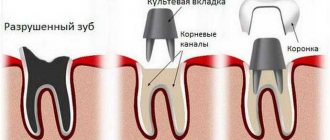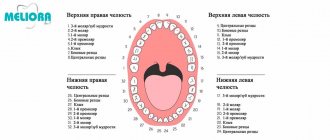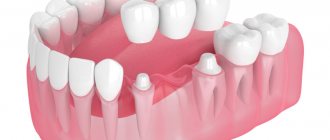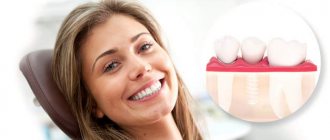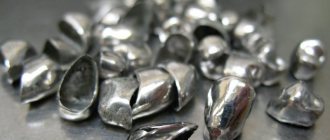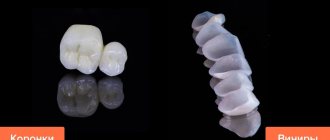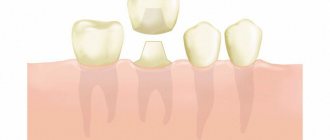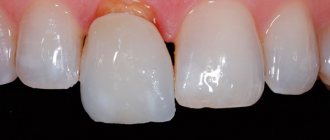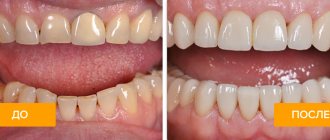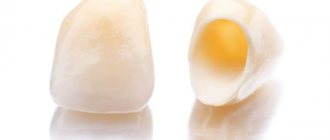We will describe in detail which crowns are best to place on chewing teeth and which on the front teeth. Our specialists have been installing the best crowns at affordable prices for over 25 years.
Many patients, before visiting a specialist, study the types of dental crowns and seek to find out which ones are best suited for each specific situation. Most people rely on forums, others ask their friends questions about the results of prosthetics. Unfortunately, only a few manage to obtain real information.
This article provides comprehensive information regarding the different types of crowns, methods of their manufacture, performance characteristics, service life and pricing policy. We hope that while reading this material you will study in detail the types of crowns on teeth and be able to understand which ones are best suited for a particular area of the jaw.
For everyone who does not know where it is best to put crowns on their teeth , we offer services of the highest level. In our clinic, all procedures are carried out under the guidance of specialists with impressive experience and deep knowledge in the field of prosthetics. In addition, we focus on using only modern durable materials, high-precision dental equipment, and implement effective technological solutions. This allows each patient to count on high-quality and long-lasting treatment results.
Types of Best Dental Crowns for 2021
Modern dentistry offers patients crowns made from various materials. It is this indicator that is key in determining the cost, quality parameters and indications for the use of a particular prosthesis. Another important criterion on which the quality of a product depends is the production method.
The following crowns are currently in demand:
- Metal-ceramic. They are among the most popular prosthetic devices. Includes a metal base and an outer facing layer of ceramics. Initially, the frame is made, after which the ceramic coating is performed. The production process can be carried out on the basis of modern computer programs and aesthetic modeling.
- All-ceramic. In the manufacture of such prostheses, metal-free ceramics are used. Provides maximum safety in relation to soft tissues, which is due to the biological inertness of this material. The manufacturing process is based on the firing technique; ceramic pressing technologies; use of milling equipment and modern digital programs.
- Crowns made of zirconium material. Despite its origin (metal), zirconium dioxide is famous for its unrivaled aesthetics and increased safety. The manufacturing process is based on the use of specialized digital programs and milling equipment. Two versions of such prostheses can be used: combined (include a base of zirconium material and ceramic lining) and monolithic (made of zirconium oxide without the use of a ceramic coating).
- Glass ceramics e.max. It is distinguished by perfect aesthetic parameters and the necessary strength. There are currently 2 material options in use: E.max RPESS - produced by injection molding using elevated pressure and temperature conditions, and E-max CAD - produced using modern digital applications and milling machines (CAD/CAM concept).
How much does prosthetics cost?
The price of metal-ceramic dentures on implants depends on the materials (their quality and quantity), manufacturing method, equipment of the dental laboratory and requirements for implantation. The most budget option for a crown starts at 7,500 rubles. If the price includes a titanium abutment, then add another 7-15 thousand. But all this is indicated without the cost of the implant (the price of which can be 15-70 thousand depending on the brand and model).
Author: Vasiliev A. A. (Thank you for your help in writing the article and the information provided)
Comparative characteristics of the best crowns
To determine which crowns are the best , you need to study the pros and cons of each product, taking into account the material used.
Next, we will compare the key parameters of various prosthetic options:
| Crown | pros | Minuses |
| Made from metal-ceramics using precious metals | Has increased strength, has a natural appearance, does not cause allergization of the body | High price |
| Made from metal-ceramics using non-precious metals | It is famous for its sufficient strength, has a reasonable price and good aesthetic parameters | There is a possibility of allergy |
| Made of ceramic material | Features impeccable aesthetic parameters and absolute compatibility with the patient’s body | Increased fragility |
| Made of zirconium material | Excellent aesthetic properties, long period of operation, absolute compatibility with the body, absence of allergic reactions | Impressive value |
| e.max crowns | Unsurpassed aesthetics, increased strength, excellent light transmittance. Emax Press has a gradient of color and transparency. | High price. Only single crowns can be installed in the chewing region. |
Crowns with a frame base made of precious metals
The frame part of a metal-ceramic crown may be made from alloys of precious metals. The cost of a metal-ceramic crown in Moscow in this version will depend on the weight of the precious metal, as well as on its type and, naturally, will be higher than the price of a product with a cobalt-chrome frame. The advantage of this type of crown is their increased strength and more aesthetic appearance.
What are the best crowns for chewing teeth?
In general, the controversial issue regarding which crown is best to place on chewing teeth may have a completely unambiguous solution. Since this department experiences increased chewing pressure, it is advisable to use high-strength and most reliable prostheses to recreate the missing units. However, despite the need to restore functional characteristics in this area, the aesthetic component should not be ignored. Moreover, making the right choice is also important from the standpoint of the biocompatibility of the material.
Next, you will get acquainted with detailed information regarding which crown is best to place on the chewing teeth, taking into account the material used:
- Metal ceramics . According to statistics, this material is among the most popular in orthopedic practice. First of all, this is due to the excellent quality and affordable prices for such crowns. As for the negative aspects, they include a significant likelihood of chipping, unlike traditional analogues. In addition, there is a risk of cyanosis appearing at the border of the gum and the prosthetic device, which has an undesirable effect on aesthetics;
- Dentures made of ceramic material . The possibility of using such crowns depends on their type. It is undesirable to fix standard ceramic structures in the masticatory region due to their significant fragility and increased likelihood of breakage. However, at the moment it has been possible to develop more durable crowns that make it possible to recreate the missing units in any area of the jaw. These include Emax and Empress glass-ceramic structures. But if you study dental crowns from the point of view of which ones are better, the price in this case is not a priority criterion (over 20,000 rubles per unit);
- Structures made of zirconium material . They allow you to recreate the missing units in the lateral section, since they are considered the most highly durable and durable prostheses. It is recommended to use monolithic crowns, which eliminates the possibility of using a porcelain coating and, as a result, minimizes the possibility of chipping. However, the price of such a prosthetic device can be higher than 30 thousand rubles;
- Emax crowns . Despite the exceptional aesthetics and excellent strength parameters (up to 400 MPa), such crowns are best used for the frontal area. For the chewing region, it is allowed to use single crowns made of E-max RPESS material obtained by pressing.
Metal-ceramic bridges –
Metal ceramics have a cast metal frame inside (Fig. 21), lined with porcelain on the outside. Unlike ceramics, metal is completely opaque, and therefore only opaque porcelain can be used to disguise it. The latter leads to the fact that metal-ceramic bridges and crowns will lack the translucency of natural tooth enamel, and their aesthetics will not be as good as that of metal-free ceramics.
The problem with aesthetics when using metal-ceramic prosthetics is somewhat reduced if you are going to prosthetize all the teeth that fall into the smile line at once (for example, at least from canine to canine). In this case, when talking, your interlocutors will see only the same “teeth”. But the problem with aesthetics is especially noticeable if a metal-ceramic bridge is installed on only 3-4 teeth, and in this case the crowns will stand out noticeably against the background of neighboring natural teeth.
Clinical case of metal-ceramic prosthetics –
The cost of 1 unit of metal ceramics varies on average from 12,000 to 18,000 rubles. Cheap metal ceramics costing from 8,000 to 10,000 rubles per unit also exist, but in this case the simplest ceramic mass (most likely of Belarusian or Russian production) will definitely be used, which simply lacks aesthetics. For 12,000 rubles per unit, you can already get bridges or crowns from Duceram ceramic mass (Germany), which at the very least provides a satisfactory level of aesthetics.
If more expensive ceramic masses are used, for example, it could be “Ivoclar” (Liechtenstein), then the cost of just 1 crown will increase to 15,000 rubles. The use of even higher quality ceramics “Noritake” (Japan) or “Vita” (Germany) will increase the cost to 18,000 rubles per unit, and therefore, if we are talking about a bridge of 3 units, then you need to multiply this amount by three. The amount of 18,000 rubles per 1 unit for good metal ceramics is not the maximum, and here’s why...
If we are talking about dental bridge prosthetics for the front teeth, then expensive ceramic mass alone is no longer enough to achieve good aesthetics. The fact is that with standard metal-ceramics, the lower edge of the metal frame (which is located just below the gum level) is not insulated with ceramics, and therefore it will always be in contact with the gum. Firstly, this leads to the gradual development of cyanosis of the gums, and secondly, to a gradual lowering of the gum level and exposure of the dark metal edge of the metal-ceramic crowns of the bridge (Fig. 24-25).
Therefore, if you are going to make a bridge on chewing teeth, all this may not be important, but in the area of the front teeth these problems will be critical. Only a type of metal-ceramic with the so-called “shoulder mass” can avoid the appearance of cyanosis, but the cost of 1 Unit of a bridge immediately increases by another 5,000 rubles (for the high complexity of manufacturing). So it turns out that for high-quality prosthetics with a bridge prosthesis for the front teeth, a bridge made of Emax metal-free ceramics can cost less than a good metal-ceramic one.
What does “metal-ceramic with shoulder mass” mean – as we said above – using a more expensive ceramic mass will not save you from the appearance of cyanosis and gum recession. For the latter, there are metal-ceramic bridges/crowns with the so-called “shoulder mass”, in which the lower edge of the metal frame is additionally insulated with ceramic mass. Ceramic insulation can be done either along the entire perimeter of the edge of the metal frame, or only on the front side of the crown (Fig. 27).
Conventional metal-ceramics and “with shoulder mass” –
As we said above, the cost of 1 unit of metal ceramics with shoulder mass will be an additional 5,000 rubles (for 1 unit). For a 3-unit bridge with shoulder mass, 2 crowns must be made, i.e. only those that will be on the supporting teeth. Accordingly, if we want a metal-ceramic bridge made of high-quality ceramics, then it will cost at least 45,000 rubles (and an additional + 10,000 rubles to this cost will also be used to create shoulder mass for crowns on abutment teeth). Total 55,000 rubles.
Important: it is worth considering that when calculating the cost of a dental bridge made of metal-ceramics, there are some other cost items. For example, the cost of temporary crowns made of plastic will be another 2,000 rubles per unit. Secondly, the cost of preparing supporting teeth for prosthetics, which can amount to another 2,500 to 8,000 rubles per tooth (depending on the number of root canals). As we see, to restore 1 missing front tooth it will be cheaper to install an economy-class implant, which even with a ceramic crown will cost you about 50,000 rubles.
An alternative to crowns for chewing teeth
It should be remembered that even in the presence of significant damage, a tooth can be restored using a conventional light-composite filling and pin. If it is necessary to eliminate a single defect, implant fixation is recommended.
Which is preferable: a filling, a pin or a crown?
As mentioned earlier, with significant destruction of the coronal part of the tooth (more than 50%), it is possible to recreate it using a light-composite filling mass. In this case, a pin made of fiberglass or metal material is used, which allows for more reliable fixation of such a filling.
If the tooth crown is destroyed by more than 50%, experts recommend resorting to the use of a prosthesis. This primarily applies to units from which the pulp has been removed, as these are considered the most fragile.
Also, in case of significant destruction of the coronal part, dentists use a special stump insert, which ensures a more durable installation of the prosthesis.
What to choose: a crown or a dental implant?
When considering the replacement of missing units with crowns, implant fixation is the preferred option for eliminating a single defect. When using a dental structure, the need to prepare teeth that act as supporting elements is eliminated. In addition, implants have a longer period of use, in contrast to single prosthetic structures and bridges.
Points to consider
If you definitely decide to install a metal-ceramic crown, then you should definitely take into account that different types of metal-ceramic products differ not only in price, but also in service life, aesthetic indicators, reliability and strength characteristics. We will tell you more about the types of metal-ceramic crowns below, but for now we will make one more important note: when planning to install a metal-ceramic crown in dentistry, it is extremely important to choose the right clinic to receive this service. Even the most expensive and well-made metal-ceramic crown will not last long if:
- The dental units were poorly prepared and ground for the installation of a metal-ceramic crown;
- When taking impressions for its manufacture, the specialist made a mistake.
Preparatory procedures for installing a metal-ceramic crown always begin with sanitation of the oral cavity and treatment of all diseases of the teeth and oral cavity identified during the examination. If the root canals of the tooth are treated incorrectly, errors are made in their filling - in the future there is a high risk of an inflammatory process occurring in them. The occurrence of inflammation can lead to the fact that the prosthesis will have to be removed, treated, and then all restoration manipulations will have to be carried out from the very beginning.
To prevent such negative consequences, the doctor must refer you for a control X-ray examination after therapeutic and other manipulations: pulp removal, canal filling.
No less important are the quality of grinding teeth for crowns and the accuracy when taking impressions. If the doctor makes a mistake at this stage of treatment or uses an inexpensive material that cannot accurately convey all the individual characteristics of the teeth, the finished crown will not adhere to their surfaces with the required degree of density. Saliva will constantly flow under it, and pathogenic microorganisms will enter, provoking the development of caries and decay in dental tissues.
For these reasons, it is recommended that before starting treatment and installing metal-ceramic crowns, make sure that you turn to professionals. Dental prosthetic services of European quality level are provided in our dental clinic in Moscow - Vanstom. If you want to find out the cost of a metal-ceramic crown, get professional advice on prosthetics from an experienced and competent specialist - come to our Vanstom dentistry! We are located in the center of Moscow, our exact address: Moscow, Baumanskaya metro station, st. Bakuninskaya, 17/28.
What are the best crowns for front teeth?
When we are trying to figure out how to choose the best crowns for the front teeth, the priority criterion is the aesthetic component. At the same time, prosthetic structures intended for the frontal region must have a natural appearance, fully correspond to natural analogues and have sufficient strength. However, when you plan to fix a crown on the front teeth, there is no point in asking: “Which dentures are better to install on the lower jaw, and which ones on the opposite side?”
In both cases, the same type of prosthetic device models are used. Below we will provide more selected information:
- Metal-ceramic crowns . Despite the reasonable cost, this is not a completely suitable option in terms of aesthetic parameters. Firstly, an undesirable bluish tint appears in the area where the prosthesis adheres to the gum. Secondly, the metal base can be viewed through the ceramic coating. Of course, today there are improved designs with shoulder mass, but their price will significantly exceed the cost of a standard crown;
- Dentures made of ceramic material . This is the most advantageous option in cases where a dilemma arises as to which crowns are best placed in the frontal part of the jaw. Moreover, for this department you can resort to the help of traditional prostheses made of all-ceramic material. Their cost is considered affordable for most patients;
- Zirconium crowns . This solution is considered one of the most expensive when it is necessary to reproduce anterior teeth. However, this option is considered preferable for those who want to find out which crowns are best to put on their front teeth, but for whom pricing policy does not matter;
- Emax crowns . Such designs are made from an improved material - glass ceramics, which has excellent aesthetics. In this case, it is advisable to choose the E-max RPESS Multi material, which has a gradient of color and transparency, which will allow you to recreate the lost frontal units with maximum identity.
What is the service life of a ceramic crown?
Metal-ceramic crowns are fixed with dental cement, which breaks down after about 5 to 7 years. However, ceramic dentures are attached to a particularly strong adhesive material, which increases their service life to 10 years.
As for strength, ceramic crowns can easily withstand the required chewing load. If a ceramic crown chips for some reason, it can be easily restored. Since the metal-free structure does not have a frame, almost any minor damage to it will be invisible. If more or less serious damage occurs, the all-ceramic crown can simply be polished.
Photos before and after installation of ceramic crowns at the Research Center. Works by Karneev A.N.
Our clinics
Clinic "Elident" on Varshavskaya
Varshavskoe highway, 75, bldg. 1, Moscow 117556
- Varshavskaya (500 m, closed until 2021)
- Nakhimovsky Prospekt (1,300 m)
Mon-Sat : 09:00-21:00; Sun : 09:00-19:00.
Online registration
+7 (495) 649-41-19
Elident Clinic in Annino
Varshavskoe highway, 154, building 1, Moscow 117405
- Annino (500 m)
- Academician Yangelya (700 m)
Mon-Sat : 09:00-21:00; Sun : 09:00-19:00.
Online registration
+7 (495) 649-41-19
Alternative options to frontal crowns
At the moment, there are three alternative methods that allow you to restore the crown part of the tooth, with destruction of no more than 50%. These include:
- Veneers. Suitable for use if there is slight destruction of the outer surface of one of the front teeth. An important requirement for carrying out a procedure using such plates is the preservation of the tooth wall from the inside. Through veneers, unsurpassed aesthetics are achieved, the possibility of tooth preservation is ensured and it is possible to significantly extend the life of the tooth;
- Dental implants. If it is necessary to reconstruct 1-2 teeth and install bridge-like prosthetic devices, it is advisable to fix the implants instead of preparing the supporting units;
- Filling material. As mentioned earlier, the option with light-composite restorations is preferable when the coronal part of the tooth is destroyed by no more than 50%.
The use of metal-ceramics in prosthetics on implants
Metal ceramics are an excellent option for use on implants. For example, it is impossible to install pure ceramics on metal roots, since they are much stronger than the material of the upper part, and under pressure the ceramics will simply fall apart. This will not happen with metal-ceramics - when fixed to implants, the internal metal base comes into contact with their top and this combination is extremely strong and durable. But external ceramics serve only to create aesthetics.
What crowns are best to put on implants?
When studying the question of which crowns are best placed on implants, one should remember the classic procedure for installing dentures. If it is necessary to recreate the missing units in the frontal region, experts give preference to the aesthetic component. The best dental crowns in this situation will be made from zirconium material or ceramic.
If you need to fix crowns on your chewing teeth, and you don’t know which ones are better, any experienced dentist will give clear advice - in this area it is advisable to install prosthetic devices made of metal ceramics, zirconium material or e.max glass ceramics. It should also be taken into account that adapters in dental structures, in the event of subsequent use of the above prostheses, must be obtained from materials that are unable to be seen through the ceramic layer.
Many patients are interested in which crowns are better, ceramic or zirconium, to be fixed to implants? According to leading experts, the most advantageous options include devices made from the innovative material E-max or zirconium dioxide.
Additionally, when evaluating whether metal-ceramic or zirconia crowns are better, it is important to consider the need for zirconia adapters. This will prevent the body from becoming allergic to metal, as well as obtain the desired aesthetic result.
Do I need to prepare implants and gums for prosthetics?
Not everyone knows how to insert a metal-ceramic crown into an implant. In fact, these two components are not enough - first you need to screw the abutment into the implant, and then fix the metal-ceramic “cap” on it. Either the prosthesis is connected to the abutment in a dental laboratory, and then the entire structure is fixed to the implant.
Read on the topic: what is an abutment, why is it needed in implantation, and what an abutment can be.
To achieve a beautiful gingival contour around the future restoration, 1-5 months after implantation of the implant, the plug is removed from it and a gum former is installed on top. This is required for single restorations, when the prosthesis does not contain artificial gum, which would mask the uneven gingival margin. After the contour of the mucous membrane is formed, the former is removed and an abutment is placed - and a prosthesis is placed on it. If the front tooth is being restored, then the role of the former is played by the abutment, covered with a temporary placer removed from the bite.
Prices for tooth crowns at Elident
When assessing dental crowns from the standpoint of which ones are better financially, one should take into account the material used, the technological solutions being implemented, the equipment used, as well as the level of professionalism of the specialist and the rating of the dental institution in which the teeth are restored.
The Elident clinic has affordable prices for all types of services related to the fixation of implants and the installation of dental crowns. At the same time, you can always count on an individual attitude and high professional training of dentists, which is combined with the use of highly effective innovative equipment and modern prosthetic concepts.
| Service | Price, ₽. |
| Consultation with an orthopedist | for free |
| Orthopantomogram - panoramic image of teeth | 950 |
| Metal-ceramic crown Degussa M with shoulder mass (Germany) | 10 500 |
| Ceramic crown Dutseram plus (Germany) | 20 500 |
| Solid crown | 5 500 |
| Ceramic crown made of zirconium dioxide | 32 000 23 000 |
| Empress crown | 19 000 |
| Metal-ceramic crown on an implant | 18 500 |
| Ceramic crown made of zirconium dioxide on an implant | 35 000 |
| Metal-ceramic crown on zirconium dioxide for Straumann implant (SPECIAL!!!) | 35 000 26 500 |
| Metal-ceramic crown on zirconium dioxide for implant Alpha Bio, BioLine, Osstem (SPECIAL!!!) | 35 000 25 000 |
| Temporary plastic crown/wedge. | 1700/1200 |
| Taking an impression from alginate mass | 300 |
| Diagnostic plaster model | 300 |
| Taking a double impression | 800 |
| Cementing inlays and crowns using Fuji cement | 700 |
| Cementing inlays and crowns using Fuji+ cement | 800 |
| Temporary cementation of one crown | 400 |
| Removing one crown with stamped sawing | 500 |
| Removing one crown with sawing the cast | 1 000 |
| Removing one crown with sawing MK | 800 |
General information and unique features
Metal-ceramic crowns are one of the most popular types of orthodontic structures among dental patients. The increased demand for this particular type of orthopedic products is explained by their durability, high aesthetics and impeccable positive results in the restoration of lost teeth. The price of metal-ceramic crowns is an order of magnitude higher than that of crowns made of metal alloys, but at the same time they are more affordable than designs made of expensive dental porcelain.
Metal-ceramic crowns have a special design: inside there is a strong frame base made of metal alloy, which is covered on the outside with a dental porcelain finish. The finish is applied to the frame base of the crown in layers: and each layer of applied material undergoes heat treatment in a specialized oven at elevated temperatures.
Layer-by-layer application and subsequent heat treatment provide super-strong adhesion between the metal base and the ceramic composition applied to it. Below we post a photo of a metal-ceramic crown; after studying it, you can see exactly what it looks like.
Further in the material, we will thoroughly understand the advantages and disadvantages of metal-ceramic crowns, and also find out why there is a fairly large price range in dental clinics for the cost of metal-ceramic crowns with work, and we will explain in detail why in this case the lowest price offer is not the most profitable, on the contrary, it can significantly increase costs.
Service life of dental crowns
If you are interested in a tooth crown and what material is best for its manufacture, an important point is the service life of the product. For example, prosthetic devices made of metal-ceramics can be used for 8-10 years, zirconium structures - over 15-20 years, glass-ceramic products - over 15 years.
However, when studying the properties of dental crowns and trying to find out which ones are better suited for prosthetics in a particular area of the jaw, one should not forget about compliance with the patient’s care requirements and the quality of the procedure performed by the dentist.
Under normal conditions, assuming proper training of the doctor and strict compliance with the production concept, the service life of crowns cannot be less than 10 years.
WHY DO YOU NEED TEMPORARY CROWNS?
Usually, before installing a crown or prosthesis, the tooth needs to be ground, and only after grinding can impressions be taken and the manufacture of dentures begin. A ground tooth looks very unsightly and causes both aesthetic and psychological discomfort to the patient. To restore the aesthetics and functionality of the dentition, temporary, or provisional, crowns are used. They are especially relevant for the front teeth. However, plastic crowns not only mask visual defects in the dentition. They perform several more very important functions: • Temporarily restore the function of a ground tooth; • Allows you to maintain normal diction; • Do not allow infection to enter the tissues of the prepared tooth; • Prevent gum tissue from growing onto the tooth to ensure normal installation of a permanent crown; • Allow a person to quickly get used to a permanent crown; • Firmly fix the tooth and prevent it from moving to the sides or staggering; • Maintains bite, preventing neighboring teeth from taking up free space; • If a tooth is ground down without removing the nerve, it becomes very sensitive to temperature and chemical stimuli, which can cause pain. A temporary crown protects such a tooth.
Caring for tooth crowns
When studying the topic of dental crowns and trying to understand which ones are better, many rely on reviews from other patients and specialists. At the same time, any qualified doctor will tell you that to extend the life of a prosthetic device, you first need to pay attention to the rules of care.
For example, if you have a single crown installed, it is enough to carry out regular hygiene procedures using toothpaste, brush and dental floss. In the presence of bridge structures, as well as in patients with periodontal pockets in the area of dentures, it is necessary to resort to the help of irrigators. These devices help clean hard-to-reach areas from dental plaque and food debris.
Article expert (author):
Rules for wearing and care
How long it takes to get used to metal-ceramic crowns depends entirely on the skill of the implantologist, orthopedist and dental technician. An ideally made product should feel like “native” and not cause inconvenience, i.e. no need to get used to it. It’s another matter when there were no teeth for a long time, and now, after prosthetics, the tongue occupies a slightly different position. Therefore, a lot of saliva appears, and difficulty with diction arises. In this case, adaptation may take 1-4 weeks. And to speed up the process, practice more often - read books, poems, tongue twisters out loud.
How to care for metal-ceramic prosthetic structures? Caring for metal-ceramic crowns is not much different from caring for your own natural teeth. Here are some recommendations that should be followed to ensure that the restoration remains functional and aesthetic for a long time:
- Maintain oral hygiene: how to clean metal-ceramic crowns? Just like your natural teeth - twice a day with a brush and paste, using a rinse and irrigator. You can also use special dental floss “super-floss”, but it is better not to use toothpicks and chewing gum,
- exclude excessively hard and brightly colored products: in order not to break the prosthesis (and even the implant!) and prevent it from becoming irreversibly stained - after all, it is not possible to bleach the ceramics,
- Visit your dentist regularly to assess the condition of the restoration, as well as to have your new teeth cleaned and polished so they will retain their original shade longer.
